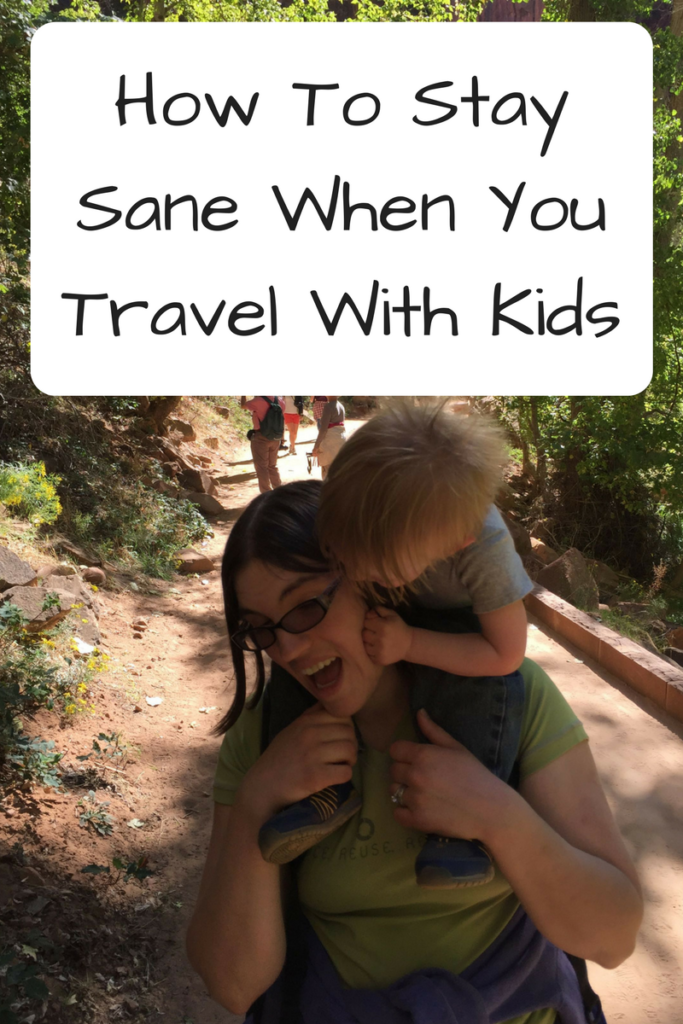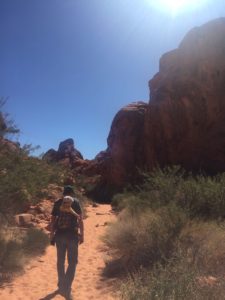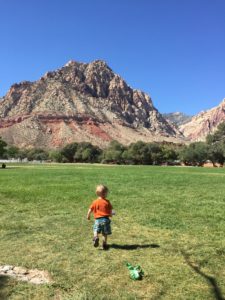
2014: Holding my one-year-old, I stared up at fireworks and started belting out Let It Go. Tears streamed down my face. It was the end of a week-long trip to Walt Disney World, during which I spent most of the time imagining my kid getting trampled. Earlier that week, my hands shook and mind went blank in the Tomorrowland snack bar as I had my first identifiable panic attack. That perfect girl is gone, indeed.
2017: Leaning over my four-year-old in his car seat in a parking lot in Nevada, I thought, “I hope he’s okay.” Right on cue, his cheeks filled, he leaned forward, and spewed out water and pretzel bits all over me. Touching my hand to my hair, it was wet and sticky. We were half-way through a three-hour car ride to Zion National Park. I breathed deep and said, “Hey honey, it’s going to be okay.” Then I got out the baby wipes and went to work cleaning up everything up.
What on earth happened in-between? In that three years, I had a second kid, started dealing with my anxiety, and grew so much as a parent. But I also learned a ton about traveling with kids. In-between the trip in 2014 and the one in 2017, we’ve been to Las Vegas, Cape Cod, multiple camping excursions, and so many day trips. While the anxiety still flairs, adjusting my expectations and my own behavior has helped me stay sane when we travel with kids.
Realize people are often much more forgiving than you expect them to be when you travel with kids

Walking into the airport a few weeks ago, my shoulders were up around my ears. Whenever I thought about taking the flight, I involuntarily twitched. Besides the sheer horror of traveling with a four-year-old and eighteen-month-old, I expected Little Bird to be impossible to keep in his seat.
“What if they start crying and people get mad?” I asked Chris, my voice taking on an edge of a whine. “Then that means they don’t like babies. That’s their problem, not yours,” he responded. The thought that people’s offense would be towards children in general and not my children in particular actually calmed me.
Much to my pleasant surprise, no one had a bad attitude – the kids or adults. Little Bird cried a little, but everything went Okay. The people sitting next to us were gracious and encouraging. Having seen that, I was so much more relaxed on the way back.
Be prepared not to sleep
Travel wrecks havoc on everyone’s sleep schedules, especially if you’re changing time zones. I thought the three-hour time difference between Washington D.C. to Nevada was tough as an adult; I was in for a whole new world of hurt doing it with two kids. Add in to the fact that you’re sleeping in a strange place, potentially all in the same room, and it’s just a total cluster. On our trip, I ended up cuddling up with our younger son almost every single night. While we don’t normally do that, it was the only way either of us was going to get any sleep.
If one or more of your kids are still napping, that’s guaranteed to get messed up as well. If you plan on doing any activity that takes more than three hours (including transportation there and back), there’s simply no way to get back to the house every single day for nap time.
Knowing everything is going to be bonkers ahead of time can help you take that into into account when you create your schedule. If you know one parent has to go back to bed after the other gets up in the morning, you can assume a slightly later start. If you know that there’s some days the baby just won’t be able to nap enough, you can schedule activities so there’s time for it at least every other day.
Embrace the more relaxed schedule and pace
Normally, I have a “Do All the Things!” travel philosophy. After all, who knows if you’re going to be back to a place or not? Unfortunately, that attitude does not jive at all with traveling with small children. You have to be willing to slow down and chill if you’re going to have any fun at all.
This is especially true if you have kids who are still napping. For us, Little Bird typically has a two-ish hour nap sometime after lunch. Even if he only got a solid nap every other day, that was still several days during which there was a big chunk of free time. Instead of stressing about what we were missing, I learned to take those mid-day breaks as a chance to rest, chill with my husband, and play with my older son. Not being go-go-go all of the time was rather nice.
Listen to and take your kids’ needs seriously
In general, I try to take my kids’ complaints seriously. In some cases, listening to them has truly saved the day. When we were most recently in Las Vegas, we attended the Tournament of Kings, a big stage and dinner show where “knights” fight each other. As Sprout puts his hands over his ears when noisy toilets flush, I let him know ahead of time that the show would probably have some loud noises. His eyes grew wide and he demanded to leave. Overhearing us, a staff member offered us earplugs. Thankfully, the “magic” earplugs allowed everyone to enjoy the show despite several loud explosions. If I hadn’t talked to him ahead of time, we may have had a disaster on our hands.
Unfortunately, kids may not always understand or be able to communicate what’s happening to them. Sometimes what they’re not staying is as important as what they are. After we finished driving through a winding mountain pass at 70 mph, I noticed Sprout was making some unpleasant noises. They sounded suspiciously like gagging. When I asked him if he was okay, he replied, “It’s just spit coming out too fast.” Uh, yeah. We pulled over at the next exit anyway. A few minutes later, I was covered in spit and puke. Good thing we didn’t write off his nausea.
Figure out exactly what you need beforehand and only pack those items
When I travel without my kids, I can usually fit everything in a carry-on bag. With my kids, we end up checking two giant suitcases, a pack-and-play, and two car seats (one full and one base). Even that is a lot less than a year ago!
With all that stuff, you want to ensure that you have just the right things – not too little, but not too much. One thing that helped us a lot this past trip was compiling the packing list a week before. By starting to make the list a week in advance, I could notice all of the stuff I was using throughout the week and decide to add it or not to the list.
As we created the list, we took a long, hard look at our schedule. Did we really need everything on there? In the end, we decided not to bring the stroller. Because we were going a lot of places that weren’t very stroller-friendly, it probably wouldn’t be useful enough to justify the extra hassle. We chose to bring the baby carrier instead.
Have a base camp
As a teenager and young adult, I grew accustomed to vacations where we packed up everything and changed locations every morning. With little kids, I’ve discovered the great benefits of having a base camp. You don’t need to pack up reams of stuff or get used to sleeping in yet another place.
Thankfully, staying one location doesn’t mean you’re stuck going to the exact same place every day. (Unless that’s what you’re into.) Staying with my in-laws, we took six different day trips, ranging from locations 10 minutes to an hour-and-a-half away. We also took one multi-day trip, where we stayed at an Air BnB outside of Zion National Park. That short break allowed us to go somewhere a little further away without having to redo everything over and over.
Know that everything takes twice as long and seems twice as scary when you travel with kids

When we first started traveling with kids, I’d add an extra 10 or 20 minutes onto my estimate of how long a task would take. I should have doubled it – at minimum. A hike that was considered “short” and “easy” at Zion took us more than two hours. Making an effort not to cram too much into a single day allowed us not to spend the whole time asking the kids to hurry up.
Even the simplest tasks can introduce risks and dangers that I never considered pre-children. As an adult, I could get shoved at Disney, but not run over. But a one year old walking through a very crowded street? A legitimate concern, albeit exaggerated in my mind. Same with ants, cacti, and all a matter of other natural risks at Zion. But preparing myself for the fact that there will be unexpected risks actually helps me prepare mentally for it instead of being surprised.
Make detailed plans, but be willing to change them at any second.
Without a plan, you can end up discussing where to go to dinner for 20 minutes while the kids are get hangrier and hangrier. Or the last-minute plans can go very wrong. In Cape Cod, we frequently ended up not eating until past 7:30 because by the time we’d pick the restaurant, there was a wait of an hour or more.
On the flip side, the more flexible I am about those plans, the less stressed I am. At Disney, we were religious about using each of our FastPass reservations (passes that allow you to skip part of the line). We were running from one side of the park to the other because I had it in my head that we absolutely had to do what we planned.
In Nevada, we constantly shifted our schedule to accommodate the changing situation. The Container Park (a playground / shopping area) didn’t open at the time we expected? We’ll go to the Children’s Museum instead! The Watchman Trail at Zion was further than we thought and we got there later than expected? We’ll do the Pa’rus Trail instead!
Being flexible also allows you to go places you didn’t know about beforehand. On the first day, my mother-in-law spotted a little Halloween festival with inflatable slides and rides. On our way to dinner, we stopped by and had a great time! If we were scheduled to the max, we wouldn’t have been to take that detour.
Set expectations for the kids
Like many small children, Sprout doesn’t do well with rapid or abrupt transitions. I’ve found talking through the trip with him beforehand works wonders. Before the Las Vegas trip, we read a book about Utah’s national parks (including Zion), looked at photos of places we were going, and talked about visiting M&M World. Involving him in the planning helped him feel important and buy-in to the activities we were doing. For activities that aren’t inherently “kid friendly,” like art museums, I play up the aspects that will appeal to them. By the time we arrive, they’re pretty excited about it. This trick works to help psych adults up too. Psychology shows that that “anticipatory pleasure” is actually a huge part of enjoying experiences.
In addition to setting expectations for the entire trip, we provided a little preview of our daily activities each morning. If nothing else, it motivated Sprout to get ready. We could point out that the later we left, the less time we’d have at a destination. It also helped him have a little more of a sense of control over the situation. With our schedule and activities changing every day, anything he could hold onto was helpful.
These days, I know I’m not perfect as a mom. Our vacations aren’t either. But by shifting my own expectations, I’ve gone from walking disaster area to relaxed enough to actually enjoy traveling with my kids.
For more on travel with kids, check out The Difference Between Being a Kid on a Trip and Being With Your Kids on a Trip. Be sure to follow us on Facebook!
